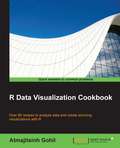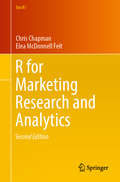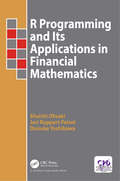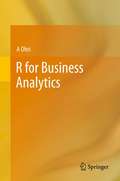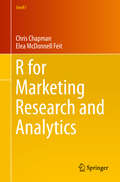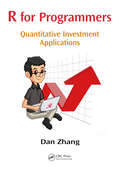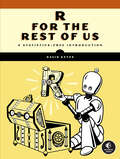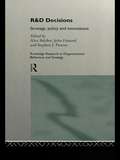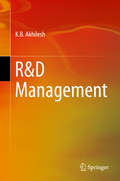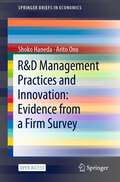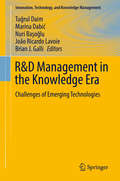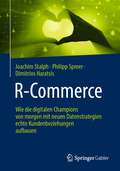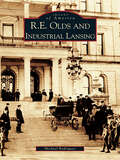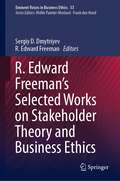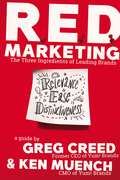- Table View
- List View
R Data Visualization Cookbook
by Atmajitsinh GohilIf you are a data journalist, academician, student or freelance designer who wants to learn about data visualization, this book is for you. Basic knowledge of R programming is expected.
R For College Mathematics and Statistics
by Thomas PfaffR for College Mathematics and Statistics encourages the use of R in mathematics and statistics courses. Instructors are no longer limited to ``nice'' functions in calculus classes. They can require reports and homework with graphs. They can do simulations and experiments. R can be useful for student projects, for creating graphics for teaching, as well as for scholarly work. This book presents ways R, which is freely available, can enhance the teaching of mathematics and statistics. <p><p> R has the potential to help students learn mathematics due to the need for precision, understanding of symbols and functions, and the logical nature of code. Moreover, the text provides students the opportunity for experimenting with concepts in any mathematics course.
R For Marketing Research and Analytics (Use R!)
by Chris Chapman Elea McDonnell FeitThe 2nd edition of R for Marketing Research and Analytics continues to be the best place to learn R for marketing research. This book is a complete introduction to the power of R for marketing research practitioners. The text describes statistical models from a conceptual point of view with a minimal amount of mathematics, presuming only an introductory knowledge of statistics. Hands-on chapters accelerate the learning curve by asking readers to interact with R from the beginning. Core topics include the R language, basic statistics, linear modeling, and data visualization, which is presented throughout as an integral part of analysis.Later chapters cover more advanced topics yet are intended to be approachable for all analysts. These sections examine logistic regression, customer segmentation, hierarchical linear modeling, market basket analysis, structural equation modeling, and conjoint analysis in R. The text uniquely presents Bayesian models with a minimally complex approach, demonstrating and explaining Bayesian methods alongside traditional analyses for analysis of variance, linear models, and metric and choice-based conjoint analysis. With its emphasis on data visualization, model assessment, and development of statistical intuition, this book provides guidance for any analyst looking to develop or improve skills in R for marketing applications.The 2nd edition increases the book’s utility for students and instructors with the inclusion of exercises and classroom slides. At the same time, it retains all of the features that make it a vital resource for practitioners: non-mathematical exposition, examples modeled on real world marketing problems, intuitive guidance on research methods, and immediately applicable code.
R Guide for Introductory Econometrics for Finance
by Chris BrooksThis free software guide for R with freely downloadable datasets brings the econometric techniques to life, showing readers how to implement the approaches presented in Introductory Econometrics for Finance using this highly popular software package. Designed to be used alongside the main textbook, the guide will give readers the confidence and skills to estimate and interpret their own models while the textbook will ensure that they have a thorough understanding of the conceptual underpinnings.
R Markdown Cookbook (Chapman & Hall/CRC The R Series)
by Yihui Xie Christophe Dervieux Emily RiedererThis new book written by the developers of R Markdown is an essential reference that will help users learn and make full use of the software. Those new to R Markdown will appreciate the short, practical examples that address the most common issues users encounter. Frequent users will also benefit from the wide ranging tips and tricks that expose ‘hidden’ features, support customization and demonstrate the many new and varied applications of the software. After reading this book users will learn how to: Enhance your R Markdown content with diagrams, citations, and dynamically generated text Streamline your workflow with child documents, code chunk references, and caching Control the formatting and layout with Pandoc markdown syntax or by writing custom HTML and LaTeX templates Utilize chunk options and hooks to fine-tune how your code is processed Switch between different language engineers to seamlessly incorporate python, D3, and more into your analysis
R Programming and Its Applications in Financial Mathematics
by Shuichi Ohsaki Jori Ruppert-Felsot Daisuke YoshikawaThis book provides an introduction to R programming and a summary of financial mathematics. <P><P>It is not always easy for graduate students to grasp an overview of the theory of finance in an abstract form. For newcomers to the finance industry, it is not always obvious how to apply the abstract theory to the real financial data they encounter. Introducing finance theory alongside numerical applications makes it easier to grasp the subject. <P><P>Popular programming languages like C++, which are used in many financial applications are meant for general-purpose requirements. They are good for implementing large-scale distributed systems for simultaneously valuing many financial contracts, but they are not as suitable for small-scale ad-hoc analysis or exploration of financial data. The R programming language overcomes this problem. R can be used for numerical applications including statistical analysis, time series analysis, numerical methods for pricing financial contracts, etc. <P><P>This book provides an overview of financial mathematics with numerous examples numerically illustrated using the R programming language.
R for Business Analytics
by A OhriR for Business Analytics looks at some of the most common tasks performed by business analysts and helps the user navigate the wealth of information in R and its 4000 packages. With this information the reader can select the packages that can help process the analytical tasks with minimum effort and maximum usefulness. The use of Graphical User Interfaces (GUI) is emphasized in this book to further cut down and bend the famous learning curve in learning R. This book is aimed to help you kick-start with analytics including chapters on data visualization, code examples on web analytics and social media analytics, clustering, regression models, text mining, data mining models and forecasting. The book tries to expose the reader to a breadth of business analytics topics without burying the user in needless depth. The included references and links allow the reader to pursue business analytics topics. This book is aimed at business analysts with basic programming skills for using R for Business Analytics. Note the scope of the book is neither statistical theory nor graduate level research for statistics, but rather it is for business analytics practitioners. Business analytics (BA) refers to the field of exploration and investigation of data generated by businesses. Business Intelligence (BI) is the seamless dissemination of information through the organization, which primarily involves business metrics both past and current for the use of decision support in businesses. Data Mining (DM) is the process of discovering new patterns from large data using algorithms and statistical methods. To differentiate between the three, BI is mostly current reports, BA is models to predict and strategize and DM matches patterns in big data. The R statistical software is the fastest growing analytics platform in the world, and is established in both academia and corporations for robustness, reliability and accuracy. The book utilizes Albert Einstein's famous remarks on making things as simple as possible, but no simpler. This book will blow the last remaining doubts in your mind about using R in your business environment. Even non-technical users will enjoy the easy-to-use examples. The interviews with creators and corporate users of R make the book very readable. The author firmly believes Isaac Asimov was a better writer in spreading science than any textbook or journal author.
R for Marketing Research and Analytics
by Chris Chapman Elea Mcdonnell FeitThis book is a complete introduction to the power of R for marketing research practitioners. The text describes statistical models from a conceptual point of view with a minimal amount of mathematics, presuming only an introductory knowledge of statistics. Hands-on chapters accelerate the learning curve by asking readers to interact with R from the beginning. Core topics include the R language, basic statistics, linear modeling, and data visualization, which is presented throughout as an integral part of analysis. Later chapters cover more advanced topics yet are intended to be approachable for all analysts. These sections examine logistic regression, customer segmentation, hierarchical linear modeling, market basket analysis, structural equation modeling, and conjoint analysis in R. The text uniquely presents Bayesian models with a minimally complex approach, demonstrating and explaining Bayesian methods alongside traditional analyses for analysis of variance, linear models, and metric and choice-based conjoint analysis. With its emphasis on data visualization, model assessment, and development of statistical intuition, this book provides guidance for any analyst looking to develop or improve skills in R for marketing applications.
R for Programmers: Quantitative Investment Applications
by Dan ZhangAfter the fundamental volume and the advanced technique volume, this volume focuses on R applications in the quantitative investment area. Quantitative investment has been hot for some years, and there are more and more startups working on it, combined with many other internet communities and business models. R is widely used in this area, and can be a very powerful tool. The author introduces R applications with cases from his own startup, covering topics like portfolio optimization and risk management.
R for the Rest of Us: A Statistics-Free Introduction
by David KeyesLearn how to use R for everything from workload automation and creating online reports, to interpreting data, map making, and more.Written by the founder of a very popular online training platform for the R programming language!The R programming language is a remarkably powerful tool for data analysis and visualization, but its steep learning curve can be intimidating for some. If you just want to automate repetitive tasks or visualize your data, without the need for complex math, R for the Rest of Us is for you.Inside you&’ll find a crash course in R, a quick tour of the RStudio programming environment, and a collection of real-word applications that you can put to use right away. You&’ll learn how to create informative visualizations, streamline report generation, and develop interactive websites—whether you&’re a seasoned R user or have never written a line of R code.You&’ll also learn how to:• Manipulate, clean, and parse your data with tidyverse packages like dplyr and tidyr to make data science operations more user-friendly• Create stunning and customized plots, graphs, and charts with ggplot2 to effectively communicate your data insights• Import geospatial data and write code to produce visually appealing maps automatically• Generate dynamic reports, presentations, and interactive websites with R Markdown and Quarto that seamlessly integrate code, text, and graphics• Develop custom functions and packages tailored to your specific needs, allowing you to extend R&’s functionality and automate complex tasksUnlock a treasure trove of techniques to transform the way you work. With R for the Rest of Us, you&’ll discover the power of R to get stuff done. No advanced statistics degree required.
R&D Decisions: Strategy Policy and Innovations (Routledge Research in Strategic Management)
by John Hassard Alice Belcher Stephen J. ProcterR&D Decisions, Strategy, Policy and Innovations explores how research and development decisions affect all of us. They are linked inextricably to the performance of firms and of economics as a whole. Their importance means that they are of concern to a large number of practitioners, policy-makers and researchers. This book demonstrates the range of issues and perspectives which R&D can encompass and at the same time brings out the elements which unite them. The papers in this book are organized into three main sections: * Strategy and Organization explores the importance of R&D and of the structures and strategies of individual organizations. The emerging 'core competence paradigm' is especially noted. * Policy and Performance looks at what new thinking on R&D more generally implies for government policy and the performance of industries, regions and economies. * Disclosure and the Market examines issues raised by changing regulations on the disclosure of R&D expenditure.
R&D Management
by K. B. AkhileshThis book contributes towards the integration of the R&D function with regard to societies, nations, industries and organizations, as well as to leaders within organizations. It covers the management aspects and approaches to R&D management and provides information on the major contexts of R&D such as in production, HR, marketing and finance - functions that are essential to attracting, developing and retaining scientific manpower. The book further elaborates on organizations' human strategic prospectives. It also suggests various types of practices to help organizations achieve their objectives and analyzes how R&D can contribute to technology, innovation and science to improve organizations' productivity. In closing, it discusses some of the challenges faced by developing countries and presents R&D management from a global perspective.
R&D Management Practices and Innovation: Evidence from a Firm Survey (SpringerBriefs in Economics)
by Arito Ono Shoko HanedaThis Open Access book provides a detailed account of firms’ research and development (R&D) management practices, and whether and how R&D management practices are associated with the success and the nature (explorative or exploitive) of innovation, using a unique survey of firms in Japan. While there is wide agreement that innovation is a key determinant for growth of firms, there are few studies that systematically and quantitatively investigate what firms do in their R&D management to create innovation. Utilizing insights from theoretical and empirical studies on innovation, the authors focus on the following four aspects of R&D management: the organizational structure of R&D, staged project management for R&D projects, compensation and incentive schemes for R&D personnel, and a firm’s risk preferences and corporate culture. The authors examine whether and how R&D management practices are linked to the likelihood of firms’ success in making product innovations and the choice between explorative and exploitive innovation. The book furnishes vital information that can be used as a reference for future theoretical and empirical analyses of R&D management practices and innovation. This monograph is highly recommended to academics and practitioners who seek an in-depth and detailed analysis of R&D management.This is an open access book.
R&D Management in the Knowledge Era: Challenges of Emerging Technologies (Innovation, Technology, and Knowledge Management)
by Tuğrul Daim Marina Dabić Nuri Başoğlu João Ricardo Lavoie Brian J. GalliThis volume explores emerging models, methods and tools in the management of research and development (R&D) in the knowledge era, with a particular focus on the challenges of the emerging technologies. The contributions are organized in five parts. Part I, Managing Emerging Technologies, provides methods and tools to understand the challenges created by the emergence of new technologies. Part II, Technology and Engineering Management Tools and Policies, explores different technology and engineering tools, including topics such as product concept development, design, selection and adoption, using technology roadmaps and bibliometrics. Part III, Technological Innovation and Entrepreneurship, explores R&D, knowledge transfer and entrepreneurial education. Part IV, Commercialization of Technological Innovations, explores the development and application of the technology transfer process which allows managers to succeed in commercializing the outcomes of R&D projects. Part V, Managing the Engineering Enterprise, explores the effect economic decision-making, leadership styles, change management and quality management have on an organization’s ability to plan and execute initiatives and projects. Research and Development has always played a critical role in the engineering and technology focused industries. In an era of big data and smart applications, knowledge has become a key enabler for R&D. Managing R&D in the knowledge era requires use of key tools and methods. However, emerging technologies pose many challenges and cause uncertainties or discontinuities, which make the task of managing R&D even more difficult. This book will examine these challenges and provide tools and methods to overcome them. Exploring such industries as automotive, healthcare, business intelligence, energy and home appliances, this book is a valuable resource for academics, scholars, professionals and leaders in innovation, R&D, technology, and engineering management.
R&R
by Howard H. Stevenson Jose-Carlos Jarillo MossiOutlines alternative mechanisms for getting into business. Shows the means by which an experienced entrepreneur can gain control over the necessary resources in order to lower the fixed costs of business entry. Provides a mechanism for discussing the role of experience, credibility, and contacts in the development of a nonbusiness venture.
R-Commerce: Wie die digitalen Champions von morgen mit neuen Datenstrategien echte Kundenbeziehungen aufbauen
by Philipp Spreer Joachim Stalph Dimitrios HaratsisDieses Buch definiert „R-Commerce“ – die nächste Evolutionsstufe im E-Commerce. „R-Commerce“ steht für Relationship-Commerce und verbindet Datenstrategie, Marketing-Technologie und Psychologie zu einem holistischen Ansatz für eine neue digitale Kundenansprache.Menschen digital zu erreichen und zu aktivieren, wird immer herausfordernder – und die rechtlichen Rahmenbedingungen immer enger. Die größten Chancen für Unternehmen liegen in einem Perspektivwechsel: weg von Kund:innen als „Umsatzbringer“ hin zum R-Commerce, der die Kundenbeziehung, den Respekt vor Nutzerdaten, und das Verstehen der tatsächlichen Bedürfnisse konsequent in den Vordergrund stellt. Wie diese Transformation gelingen kann, zeigen die Autoren anhand der drei grundlegenden Gesetze im R-Commerce. Daraus ergibt sich ein ganzheitliches Konzept, das strategische, technische und organisatorische Aspekte integriert und zugleich die Bedeutung der Psychologie im digitalen Marketing und Vertrieb betont. Ergänzt durch zahlreiche Praxisbeispiele ist dieses Buch ein detaillierter Leitfaden auf dem Weg zum digitalen Champion. Mit einem Gastbeitrag von Prof. Dr. Eric Eller, Studiengangsleiter für Medienpsychologie an der Technischen Hochschule Ingolstadt und als Behavioral Designer bei elaboratum. Aus dem InhaltAuf die Beziehung kommt es an: Aus „E-Commerce“ wird „R-Commerce“Menschen und ihre Entscheidungen verstehen – der Schlüssel im MarketingNeue rechtliche und technische Rahmenbedingungen Was R-Commerce Unternehmen bringt und welche Voraussetzungen es brauchtDer R-Commerce-Fahrplan: der Weg zur datengetriebenen und bedürfniszentrierten KundenbeziehungDie Zielgruppe für R-Commerce-Umsetzung:CEOs und General Manager, die eine strategische Einordnung der wichtigsten Entwicklungen im datengestützten Digital-Business suchen, um Wachstumsperspektiven zu erkennen. CMOs und andere Marketingverantwortliche, die akute Effizienzverluste bereits heute feststellen oder künftig kommen sehen und einen Ausweg aus der Krise finden wollen. CDOs und Business-Intelligence-Verantwortliche, die mit ihrem datenfokussierten Mindset alle Kolleg:innen mitreißen und die beste aller möglichen Datenstrategien identifizieren wollen. CTOs, CIOs und andere Technologie-Verantwortliche, die sich fragen, ob das bestehende Tech Stack die Herausforderungen der beziehungsorientierten Kundenansprache in Echtzeit bewältigen kann. Alle Expert:innen quer durch alle Hierarchieebenen, die direkt oder indirekt für Kund:innen arbeiten und ihren Horizont interdisziplinär erweitern wollen. Leserstimme„R-Commerce schaut nicht operativ auf Marketingkanäle, sondern wirft die Grundsatzfrage im digitalen Marketing auf. Die Autoren setzen sich damit frühzeitig mit einem der zentralen Themen der aktuellen Zeit auseinander – wie findet man zu nachhaltigen Kundenbeziehungen in der digitalen Welt? Empfehlung!“ (Philipp Westermeyer, Gründer von OMR)„Mich begeistert der ganzheitliche Ansatz einer neuen Business-Philosophie: Daten, Technologie und Psychologie müssen heute zusammengedacht werden, um Menschen zu verstehen und Produkte digital zu verkaufen.“ (Björn Kolbmüller, Gründer von Flaconi, Zenloop und Jacasa)„R-Commerce erzeugt Aufbruchstimmung. Kundenzentrierung und -beziehungen sind bereits feste Werte in der Digitalbranche. Mit der richtigen Strategie, Datengrundlage und Tech-Stack werden diese Werte im Buch neu definiert und auf ein neues Niveau gehoben.“ (Fabian Frank, Global Head of Digital Sales and Marketing bei Allianz SE)„Das richtige Buch zur richtigen Zeit. Nachhaltige Kundenbeziehungen sind in einer Welt aus Walled-Garden
R. E. Olds and Industrial Lansing (Images of America)
by Michael RodriguezUpon the dedication of a new Capitol building in 1879, the city of Lansing was just beginning to emerge from the swampy wilderness of its recent past. As industry began to take root along the banks of the Grand River, Ransom Eli Olds brought his father's motor shop to national prominence with advancements in gasoline and steam engines, and then horseless carriages. By the early 20th century, Oldsmobile became the world's first mass producer of automobiles and Olds had moved on to found a second car company, making Lansing the first Auto City. Through these efforts, Olds rose to become one of the nation's greatest industrialists and entrepreneurs. Using primary documents and historical images, this book traces the industrial history of the Capital City within the context of one of the 20th century's greatest entrepreneurs, R.E. Olds.
R. Edward Freeman’s Selected Works on Stakeholder Theory and Business Ethics (Issues in Business Ethics #53)
by R. Edward Freeman Sergiy D. DmytriyevEd Freeman’s influential ideas on stakeholder theory, business ethics, humanities, and capitalism became foundational in the management field and turned around the mainstream thinking about business. Stakeholder theory developed by Freeman and others posits that business is not as much about profits, but rather about creating value for its stakeholders, including employees, customers, communities, financiers, and suppliers. The relationship between a company and its stakeholders is the essence of business and should be of utmost attention to its managers. Managers should avoid resorting to trade-offs by prioritizing one stakeholder group (e.g., shareholders) over the others and strive to run their companies in the interests of all stakeholders. The idea of pursuing the interests of all stakeholders became revolutionary in management and went far beyond the management field, expanding to Law, Health Care, Education, Public Policy and Administration, and Environmental Policy. This book is a collection of Ed Freeman’s most influential and important works on stakeholder theory as well as business ethics, humanities, and capitalism.
R.E.D. Marketing: The Three Ingredients of Leading Brands
by Greg Creed Ken MuenchCreate breakthrough marketing campaigns that achieve staggering consumer response rates by harnessing the power of R.E.D. Marketing: a transparent and flexible methodology from the CEO and CMO of marketing powerhouse Yum! Brands—Taco Bell, KFC, Pizza Hut—with a genuine track record of success.Sidestep the other marketing books, courses, articles, and even TED talks that offer hypothetical explanations that sound sensible. Embrace the proven, systematic approach of RED Marketing, which the recent CEO and current CMO of Yum! Brands applied to lead Taco Bell and KFC to double digit growth—no PhD required!In 2011, Greg Creed had just been elevated from President to CEO of Taco Bell, a brand in deep distress at the time. It was on his shoulders to turn things around quickly along with co-author and CMO, Ken Muench. Together they developed the R.E.D (Relevance, Ease, Distinctiveness) method. It&’s simple methodology does not require complicated terms and a PhD to understand, it&’s actually quite simple—marketing works in three very different ways:Relevance—Is it relevant to the marketplace?Ease—Is it easy to access and use?Distinction—Does it stand out from competition?Combining actual examples from Yum! and other recognizable brands of every size around the world; the latest findings in marketing, neuroscience, and behavioral economics; and the author&’s own experience marketing three different brands across 120 countries—your brand can set and achieve a truly breakthrough marketing campaign utilizing R.E.D Marketing.
R.J. Reynolds International Financing
by W. Carl Kester William B. AllenReynolds must source a substantial portion of the financing of its Nabisco acquisition in offshore bond markets. Morgan Guaranty has proposed a yen/dollar dual currency Eurobond that could be hedged into dollars. This structure is compared to Eurodollar Bonds, Euroyen Bonds, and Euroyen Bonds swapped or hedged into dollars.
R.R. Donnelley & Sons: The Digital Division
by David A. Garvin Artemis MarchIn June 1995, Barbara Schetter, VP and general manager of R.R. Donnelley's Digital Division, is struggling to gain acceptance from other groups and divisions at the printing giant. The Digital Division employs radically new technology--digital printing presses and transactions management systems--to deliver short-run, customized printing. But it is based on a completely different business model than Donnelley's traditional businesses and is finding it difficult to overcome informal resistance.
R.R. Donnelley: Country and Opportunity Analysis in Eastern Europe
by Robert E. KennedyExamines several market entry options for R.R. Donnelley's expansion into Eastern Europe. Used as an introduction to a Harvard Business School course titled "New Opportunities in Emerging Markets." Asks students to consider the following issues: 1) the impact of macroeconomics and political instability on project profitability, 2) market research in an emerging market, 3) choice of a joint venture partner, 4) geographic versus industry diversification, and 5) capital structure.
R/GA: Corporate Venture Studio vs. Accelerator
by Andy Wu Grant Son Aastha ThakkarNew approach to accelerating the development of innovation through corporate venturing by creating partnerships between startup venture and established corporations through the launch of the Global Sports Venture Studios created by R/GA Ventures and the Los Angeles Dodgers.
RB
by Joshua D. Margolis Vincent Dessain Jerome LenhardtAs 2016 was approaching its end, Rakesh Kapoor, CEO of RB, one of the world's major fast moving consumer goods (FMCG) companies, envisioned the prospect of a major acquisition that would add a line of health-related products that promised growth in the developing markets of Asia. The acquisition would also move RB closer in size to its better-known rivals, such as Unilever or P&G. RB, formerly Reckitt Benckiser, produced health, hygiene and home products and its strategy revolved around 19 top-selling global brands known as Powerbrands, such as antiseptic Dettol or sore throat medicine Strepsils, cold remedy Mucinex. In 2016, the company recorded sales of $13.4 billion and a market capitalization of $62 billion. Kapoor wondered whether the moment was ripe for a major acquisition or if the organization needed more time to adapt to its new health and hygiene oriented strategy and some key organizational changes. Could Kapoor keep what made RB so unique among its FMCG peers intact through this transformation, and would an acquisition advance or jeopardize what distinguished RB?
RBC: Transforming Transformation (A)
by Francesca Gino Aldo Sesia Ethan S. BernsteinHistorically, personal and commercial banks (P&CB) maintained long relationships with their clients who tended to do most if not all of their banking with one bank. However, by 2017, industry-wide change was well underway as switching costs had become negligible if not non-existent. New entrants were disrupting the banking industry as digitization allowed upstarts to break through long-standing barriers to entry. RBC's Cultural Transformation, intended to reposition the enterprise for the "new normal" in the financial industry, included the creation of this team of collaboration enablers (called Operations Transformation or OT) to drive efficiencies across operations within the current fulfillment operating model and importantly to envision and enable a new digital operating model where people only intervened in a transaction when there was an exception, i.e., a transaction that fell outside the technology's capabilities. OT was tasked with enabling-through collaboration and without radical surgery-the day-to-day optimization of P&CB fulfillment activities and facilitating major change in the way work was done. At the time of the case, eighteen months in, the team was seeing mixed results, which deeply troubled its leadership. Questions abounded: Was it foolish to try to enable major change through collaboration without upending the traditional RBC organization with more radical approaches? Or was the OT group not structured correctly to enable it-and if not, what changes should be made? Was a different collaboration model needed? Internally, some questioned whether the group was optimally located within the organization (as part of the back office organization structure), since the back office was often viewed as more of a servant to the front office. Others wondered if OT's internal structure was getting in the way of its purpose.
